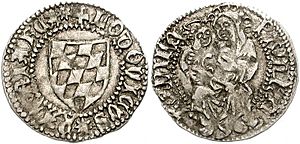Soldo facts for kids
The soldo was a type of coin used in Italy a long time ago, during the Middle Ages. It was first made from silver in the late 1100s. This happened in the city of Milan, thanks to Emperor Henry VI. The name "soldo" comes from an even older Roman coin called the solidus.
Contents
What Was the Soldo Coin?
The soldo was a small coin that became very popular across Italy. Many cities started making their own soldi. These included important places like Genoa and Bologna.
The Soldo in Venice
In the famous city of Venice, the soldo was made for a very long time. It started during the rule of Francesco Dandolo. Even after Venice stopped being an independent republic in 1797, the soldo was still used. It stayed in use during the time Austria controlled Venice, right up until 1862.
How Much Was a Soldo Worth?
In the 1300s, in the city of Florence, a soldo had a specific value. It was worth one-twentieth of a lira. It was also equal to 12 denari. So, you needed 20 soldi to make one lira.
Changes to the Soldo Over Time
As the years went by, the materials used to make the soldo changed.
From Silver to Copper
At first, the soldo was a silver coin. But later, it started to be made from a mix of metals called billon. This metal mix was not as valuable as pure silver. By the 1700s, the soldo was often made from copper.
Soldo's Value in Later Years
During the 1800s, when Leopoldo II of Tuscany was in charge, a soldo was worth three quattrini. Later, when Napoleon Bonaparte changed the money system in Italy, the soldo became worth 5 cents. This meant that 20 soldi were needed to make one lira.
Where the Name "Soldo" Comes From
The word "soldo" has an interesting history. In medieval times, it was used to describe the money paid to soldiers. Because of this, the word "soldo" became a way to say "pay" or "wages" in both Italian and German. In German, the word for soldier's pay is still Sold.


